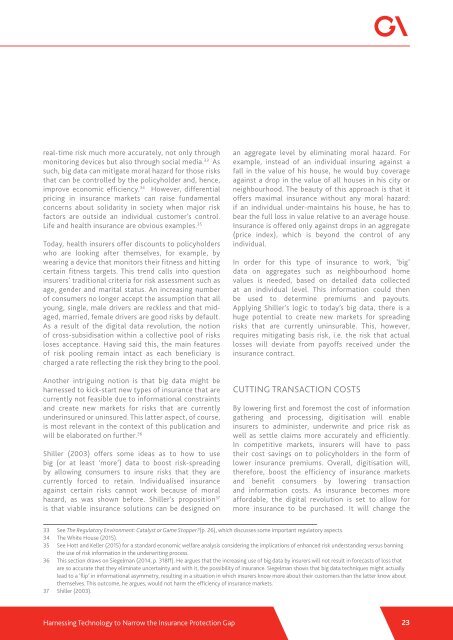Harnessing Technology to Narrow the Insurance Protection Gap
harnessing-technology-to-narrow-the-insurance-protection-gap
harnessing-technology-to-narrow-the-insurance-protection-gap
You also want an ePaper? Increase the reach of your titles
YUMPU automatically turns print PDFs into web optimized ePapers that Google loves.
eal-time risk much more accurately, not only through<br />
moni<strong>to</strong>ring devices but also through social media. 33 As<br />
such, big data can mitigate moral hazard for those risks<br />
that can be controlled by <strong>the</strong> policyholder and, hence,<br />
improve economic efficiency. 34 However, differential<br />
pricing in insurance markets can raise fundamental<br />
concerns about solidarity in society when major risk<br />
fac<strong>to</strong>rs are outside an individual cus<strong>to</strong>mer’s control.<br />
Life and health insurance are obvious examples. 35<br />
Today, health insurers offer discounts <strong>to</strong> policyholders<br />
who are looking after <strong>the</strong>mselves, for example, by<br />
wearing a device that moni<strong>to</strong>rs <strong>the</strong>ir fitness and hitting<br />
certain fitness targets. This trend calls in<strong>to</strong> question<br />
insurers’ traditional criteria for risk assessment such as<br />
age, gender and marital status. An increasing number<br />
of consumers no longer accept <strong>the</strong> assumption that all<br />
young, single, male drivers are reckless and that midaged,<br />
married, female drivers are good risks by default.<br />
As a result of <strong>the</strong> digital data revolution, <strong>the</strong> notion<br />
of cross-subsidisation within a collective pool of risks<br />
loses acceptance. Having said this, <strong>the</strong> main features<br />
of risk pooling remain intact as each beneficiary is<br />
charged a rate reflecting <strong>the</strong> risk <strong>the</strong>y bring <strong>to</strong> <strong>the</strong> pool.<br />
Ano<strong>the</strong>r intriguing notion is that big data might be<br />
harnessed <strong>to</strong> kick-start new types of insurance that are<br />
currently not feasible due <strong>to</strong> informational constraints<br />
and create new markets for risks that are currently<br />
underinsured or uninsured. This latter aspect, of course,<br />
is most relevant in <strong>the</strong> context of this publication and<br />
will be elaborated on fur<strong>the</strong>r. 36<br />
Shiller (2003) offers some ideas as <strong>to</strong> how <strong>to</strong> use<br />
big (or at least ‘more’) data <strong>to</strong> boost risk-spreading<br />
by allowing consumers <strong>to</strong> insure risks that <strong>the</strong>y are<br />
currently forced <strong>to</strong> retain. Individualised insurance<br />
against certain risks cannot work because of moral<br />
hazard, as was shown before. Shiller’s proposition 37<br />
is that viable insurance solutions can be designed on<br />
an aggregate level by eliminating moral hazard. For<br />
example, instead of an individual insuring against a<br />
fall in <strong>the</strong> value of his house, he would buy coverage<br />
against a drop in <strong>the</strong> value of all houses in his city or<br />
neighbourhood. The beauty of this approach is that it<br />
offers maximal insurance without any moral hazard:<br />
if an individual under-maintains his house, he has <strong>to</strong><br />
bear <strong>the</strong> full loss in value relative <strong>to</strong> an average house.<br />
<strong>Insurance</strong> is offered only against drops in an aggregate<br />
(price index), which is beyond <strong>the</strong> control of any<br />
individual.<br />
In order for this type of insurance <strong>to</strong> work, ‘big’<br />
data on aggregates such as neighbourhood home<br />
values is needed, based on detailed data collected<br />
at an individual level. This information could <strong>the</strong>n<br />
be used <strong>to</strong> determine premiums and payouts.<br />
Applying Shiller’s logic <strong>to</strong> <strong>to</strong>day’s big data, <strong>the</strong>re is a<br />
huge potential <strong>to</strong> create new markets for spreading<br />
risks that are currently uninsurable. This, however,<br />
requires mitigating basis risk, i.e. <strong>the</strong> risk that actual<br />
losses will deviate from payoffs received under <strong>the</strong><br />
insurance contract.<br />
CUTTING TRANSACTION COSTS<br />
By lowering first and foremost <strong>the</strong> cost of information<br />
ga<strong>the</strong>ring and processing, digitisation will enable<br />
insurers <strong>to</strong> administer, underwrite and price risk as<br />
well as settle claims more accurately and efficiently.<br />
In competitive markets, insurers will have <strong>to</strong> pass<br />
<strong>the</strong>ir cost savings on <strong>to</strong> policyholders in <strong>the</strong> form of<br />
lower insurance premiums. Overall, digitisation will,<br />
<strong>the</strong>refore, boost <strong>the</strong> efficiency of insurance markets<br />
and benefit consumers by lowering transaction<br />
and information costs. As insurance becomes more<br />
affordable, <strong>the</strong> digital revolution is set <strong>to</strong> allow for<br />
more insurance <strong>to</strong> be purchased. It will change <strong>the</strong><br />
33 See The Regula<strong>to</strong>ry Environment: Catalyst or Game S<strong>to</strong>pper?(p. 26), which discusses some important regula<strong>to</strong>ry aspects.<br />
34 The White House (2015).<br />
35 See Hott and Keller (2015) for a standard economic welfare analysis considering <strong>the</strong> implications of enhanced risk understanding versus banning<br />
<strong>the</strong> use of risk information in <strong>the</strong> underwriting process.<br />
36 This section draws on Siegelman (2014, p. 318ff). He argues that <strong>the</strong> increasing use of big data by insurers will not result in forecasts of loss that<br />
are so accurate that <strong>the</strong>y eliminate uncertainty and with it, <strong>the</strong> possibility of insurance. Siegelman shows that big data techniques might actually<br />
lead <strong>to</strong> a ‘flip’ in informational asymmetry, resulting in a situation in which insurers know more about <strong>the</strong>ir cus<strong>to</strong>mers than <strong>the</strong> latter know about<br />
<strong>the</strong>mselves. This outcome, he argues, would not harm <strong>the</strong> efficiency of insurance markets.<br />
37 Shiller (2003).<br />
<strong>Harnessing</strong> <strong>Technology</strong> <strong>to</strong> <strong>Narrow</strong> <strong>the</strong> <strong>Insurance</strong> <strong>Protection</strong> <strong>Gap</strong><br />
23


